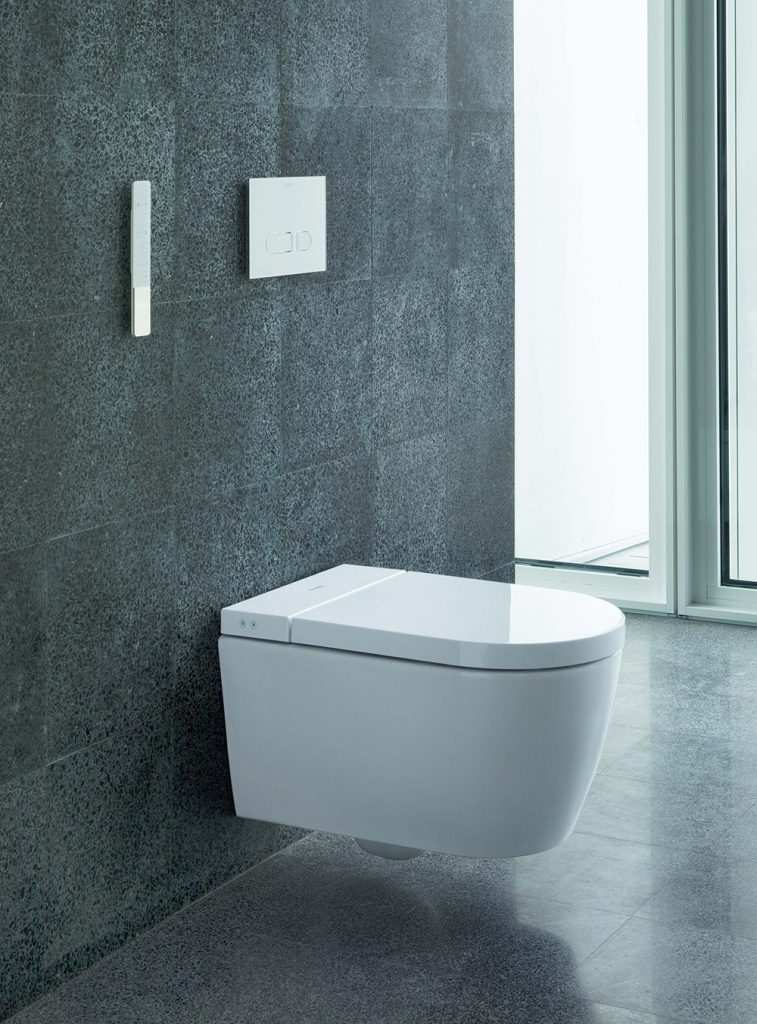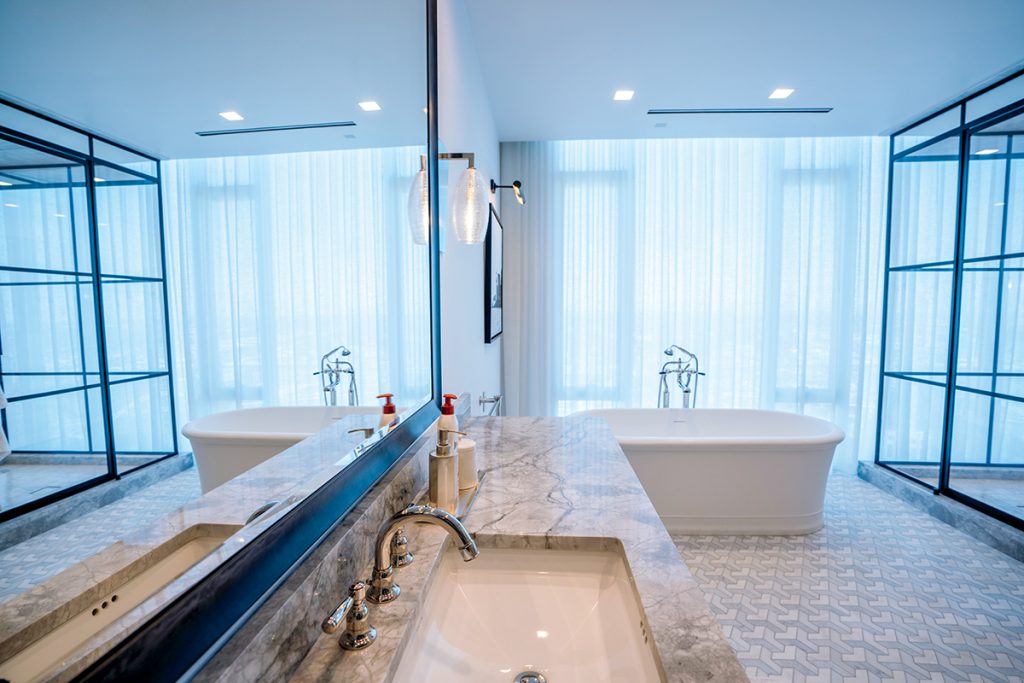Our homes are getting smarter, but are we? Are our trade partners and clients? And how smart should that be, it’s important to ask. The answers are mixed, with a few hints of skepticism, but they’re mostly trending toward the positive. There’s much to be gained from technology that makes our chores easier, our homes safer and more accessible, and our lives more fun and functional.
To get some smart takes on the subject of smart home technology in our kitchens and bathrooms, I reached out to six industry groups and experts:
- National Kitchen & Bath Association Research Director Tricia Zach
- Home Technology Association CEO Josh Christian
- Independent technology specialist and former senior director of strategic partnerships at CEDIA Ian Bryant
- Builder support consultancy and conference organizer TecHome Advisors Principal Joe Lautner
- Build with Ferguson (formerly Build.com) Design Manager Glenn Rush
- John Burns Real Estate Consulting’s DesignLens Director Jenni Nichols
OVERVIEW
“We are on the cusp of a next generation of smart homes that will revolutionize the way we live,” declares a recent John Burns homeowner study. NKBA is also taking a hard look at this rising topic. The latter’s 2022 trend reports show that clients are interested in smart home features.
Gen Xers and Boomers are showing up in these trends, Zach says, but Millennial interest was so strong that it generated its own research; the NKBA wanted to know what technology this behemoth generation of new homebuyers is interested in – and found that the trends carried over to the pro side. Technology is more intuitive to younger designers, the researcher says. “Other designers lack the knowledge” and, she confides, there’s an element of intimidation. That’s going to be challenging to technophobes’ business prospects. “Tech isn’t going away,” she cautions. “It is a disservice to clients by not being knowledgeable in this area.”
At this time, designers are incorporating technology into about 30 percent of their projects, she reports, unable to predict when those numbers will significantly rise. One challenge for designers is finding trusted technology partners or knowing how to work with them, Zach shares. Partners like CEDIA and the Home Technology Association help in providing information and connections.

Photo: Project by Paul Knutson, Photography by Troy Thies / National Kitchen & Bath Association
IN THE KITCHEN
Kitchens have been called the ‘hub of the home’ long before smart technology showed up in these spaces. Now they may literally house those hubs. “There is one that sits above your range, another built into the front door of a microwave, and then a few on the door of your refrigerator,” Bryant observes. They let the homeowner view and store recipes, watch TV and even turn your countertop into a keyboard and display.
With all this technology, designers and homeowners still want these busy rooms to be sleek and stylish. Smart home systems that simplify lighting controls and eliminate dreaded “wall acne” are highly desired, HTA’s Christian comments, replacing multiple switches with single keypads or device controllers. There are flush-mount kits that camouflage outlets, switches, HVAC registers and Wi-Fi access points, he adds.
Single app user experiences that allow one button to accomplish many tasks at once are becoming more popular. For example, an ‘Entertain’ preset can adjust the kitchen’s lighting scenes, synchronize a music playlist, adjust the HVAC, turn the TVs into digital art displays and more,” Christian explains.
Fixtures and Faucets: Among the most popular tech-enabled offerings with survey respondents, Zach reports, are hands-free faucets with motion or voice activation and taps that elevate water purity. Bryant points out that voice-
controlled faucets that let a user specify a quantity and temperature make independent living much easier for someone with a physical challenge.
Ferguson’s Rush adds that they also offer savings. “The smart faucet has been engineered to offer excellent controlled water flow, down to the ounce, aiding water conservation. In addition, some manufacturers offer models that check for leaks or water flow problems.”
Appliances: Zach sees innovations that help clients with precision cooking technology, open door detectors, menu ideas, mobile alerts and food inventory tracking. “Healthy cooking and app-controlled appliances will have strong Millennial draw,” Zach predicts. Bryant expects residential gas bans to help spur induction sales; these often now sync with ventilation hoods, adding to their wellness potential. He also sees advances in oven sensing technology for better cooking control and content tracking for refrigerators.
“If you have been to an Amazon Go or Fresh store where you grab your items and walk out without stopping at a cashier, this is RFID technology at work,” the technology pro explains. “Think about placing those items in your fridge and every time you take something in or out it is documented in the refrigerator’s software that you can check from your phone.” There is still a way to go on this technology, he points out, but there are other possible solutions emerging for monitoring and notifying you of food going bad.
Dishwashers have gotten new technology, too. “When a problem arises, it notifies the manufacturer remotely,” Rush shares. This capability can save the homeowner problems, time and the cost of an in-house repair if remote diagnosis and repair are possible.
TecHome’s Lautner points out that some appliances are now shipped upgrade-enabled, citing ovens: “With over the air software updates, new features like air frying or optimal turkey cooking settings can be added.” He also points to the growth of indoor plant growing appliances for herbs and vegetables.
John Burns’ Nichols is seeing robotic vacuums trending. She’s also bullish on “countertop dishwashers for small loads and energy/water efficiency.”
Extras: Our kitchen-based leisure delights are getting smarter, too. NKBA research shows wine dispensers, integrated speakers, audio systems and even video enhancements getting installed. “TVs can be hidden in cabinets or even beneath the countertop and ‘reveal’ through motorized lifts, or even ‘reveal’ out of the wall behind motorized panels,” HTA’s Christian says, and speakers can be designed to match recessed lighting or even become invisible, he adds.
Tech-Centric: The tendency of users to carry their devices into the kitchen has led to “charging stations and power outlets being designed within drawers,” Zach says. She also sees dedicated areas for using one’s devices and wall-mounted touch panel interfaces. “Voice-activated lighting controls are also a top kitchen tech for Millennials,” the research director observes, predicting that this technology will become as popular as dimmers. Technology is also making our homes safer with integrated vent hoods, leak detectors and power failure and gas leak detectors.
Lautner notes that builders are getting strategic in their approaches to sleekly include features, describing “glass walls at the back of counters that raise and lower to expose or hide countertop appliances and spice or utensil storage that retract into counters.”

Photo: Crestron Electronics / Home Technology Association
IN THE BATHROOM
Bathrooms are getting smarter, too, with better air and water quality management, as well as enhanced showers, comfort, window shadings and storage. They’re also getting more comfortable. “Some 79 percent of respondents cited heated flooring as a trend in the next three years,” Zach says. She also sees greywater collection systems for irrigation gaining popularity with regional droughts becoming more common.
TecHome’s Lautner is seeing Bluetooth speakers built into fans. “As fans were made quieter, some people didn’t like it due to the privacy factor that fan noise added. Speakers were introduced, in part, to solve this,” he comments.
Ferguson’s Rush is seeing “fans utilizing UV light to clean the air and surfaces of your bathroom [with the] ability to prevent mold, bacteria and fungi growth on surfaces.” In the future, he predicts, “There’s the possibility that sensors will be so sophisticated that they could provide reports alerting you if there is a flu virus.”
“Another technology trend is human centric lighting systems,” Christian comments. These let your primary suite bring bright, cool light in the morning for energy and focus, and warm hues in the evening to ease you toward sleep.

Photo: Duravit available at Build by Ferguson
Fixtures and Faucets: Spa-inspired bathrooms often get steam showers and related technology upgrades, Rush says. “In the future, more manufacturers will look for ways to incorporate little luxuries like aromatherapy and chromatherapy into the experience.” One of those luxuries, for both steam and traditional models, is a convenient drying system that eliminates the squeegee need and offers an easier-to-clean shower, notes Nichols.
“Smart, bidet and low-flow toilets will be popular, along with humidity and steam-sensor exhaust fans,” Zach says. So will touchless and voice-controlled faucets, she predicts.
Rush is also seeing increased interest in hands-free toilet flushing and self-clean modes. “These promote increased hygiene and reduce manual cleaning time,” he shares. “One manufacturer announced it had recently started developing a new toilet that, when the user is directly in contact with it, checks the individual’s biometrics, scans and performs an analysis for tracking and health recommendations.” As we saw with COVID-19, wastewater can predict virus outbreaks, making this technology promising.
In the meantime, your system can already diagnose plumbing problems. “Water monitors on the bathroom faucets and toilets allow for flow detection; say your toilet has a slow leak, you’ll know before your water bill skyrockets,” Bryant explains. “Or if someone was to leave the faucet on by accident or, in worst case, fell and couldn’t get up, it can be turned off via a phone or voice command.” (There are also alerts to let you know a loved one has fallen in order to help them. Nichols points to floor sensors for that purpose.)

Photo: GROHE available at Build by Ferguson
Bryant adds, “We are getting close to having real time water quality systems in homes that can detect contaminants in your water, notify you and make changes to the filtration system or shut the water off altogether to keep from contaminating the home’s system.”
Since hands-free faucets are so popular, “a few manufacturers offer the ability to retrofit their older residential bathroom faucets models with sensors,” Rush says. “This allows homeowners to upgrade an older bathroom faucet to hands-free activation without upgrading a matched bathroom suite of plumbing fixtures.”
Extras: “Built in charges, speakers, music, TVs and Bluetooth activations” rank high in NKBA research, Zach says. “Integrated outlets and storage to eliminate countertop messes” are also popular.
There are new ‘tile’ speakers that get installed with the standard tile on your shower surround and audio technology that can turn a glass shower wall into a speaker, Bryant says.

Photo: Sonance / Home Technology Association
“Much of the same technologies for kitchens are asked for in bathrooms,” Christian observes, citing lighting, audio and climate controls. “Motorized shadings are popular,” he notes, as is “smart glass that can switch quickly between clear or opaque at the press of a button” for privacy.
“Hopefully this becomes a growing trend!” he suggests. Bryant agrees and urges designers, contractors and integrators to plan for electrical outlets at sinks to accommodate technology enhancements like voice control. Many have started doing this for bidet functionality next to toilets. This is the next frontier.
LAST WORDS
“If the client is building or remodeling a luxury home, such technology is expected now. Not having these amenities will affect the home’s value and desirability for later resale,” Christian warns.
“As more homeowners attempt to juggle multiple roles and responsibilities in the home, the kitchen and bath must incorporate products that help them do the same,” says Rush.
Burns’ Nichols sees technology’s value, but offers pros a few caveats. “Make sure systems are easy to use and talk to each other, while also considering shelf life. Buyers don’t want to get tech in their home that will be irrelevant in a year or two.” She also advises not ignoring privacy and security concerns. “Figure out ways to make products and networks more secure and built trust with potential buyers.”
Technology can make life better for all, but it needs to be smartly planned.
Original post here


0 Comments